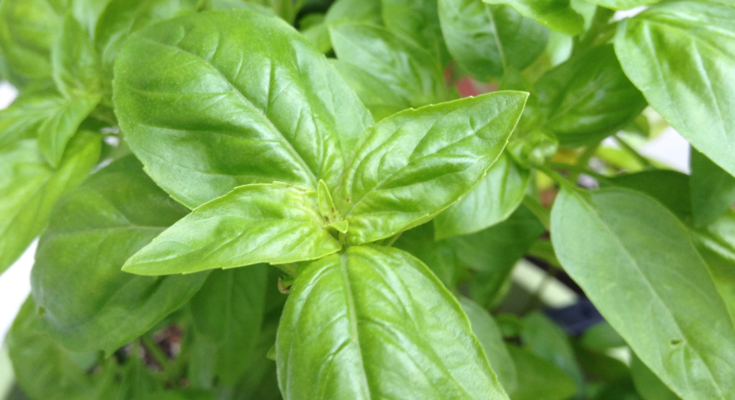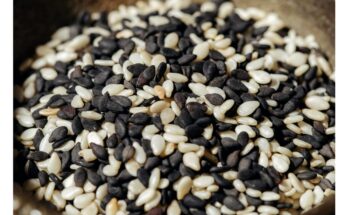Basil (Ocimum basilicum), commonly known as sweet basil, is a popular plant native to India. It is an upright, highly branched, smooth, sturdy, and aromatic herb, typically growing between 35 to 85 cm in height.
The plant’s fresh leaves are vibrant green, measuring about 3.7 cm in length, and they turn brittle and brownish-green when dried. Both the dried leaves and tender stems are used as a spice for flavoring dishes and extracting essential oils. The leaves are dotted with tiny oil glands, which contain the plant’s characteristic aromatic oil.
Sweet basil is known for its aromatic, clove-like scent, with a slightly salty, sweetish taste that intensifies during cooking. There are several varieties of basil, four of which are commonly found in India: lettuce-leaf basil, curly-leafed basil, violet-red basil, and common white basil. Among these, curly-leafed basil is preferred for cultivation due to its high-quality oil yields. It grows easily in gardens and can thrive in ordinary soil.
The nutritional profile of basil includes moisture (6.1%), protein (11.9%), fat (3.6%), fiber (20.5%), carbohydrates (41.2%), and ash (16.7%). It also contains calcium (2.1%), phosphorus (0.47%), sodium (0.04%), potassium (3.7%), and iron (0.04%). In terms of vitamins, basil provides thiamine (0.15 mg/100g), niacin (6.9 mg/100g), riboflavin (0.32 mg/100g), ascorbic acid (61.3 mg/100g), and vitamin A (290 IU/100g). The dried herb contains 325 calories per 100g.
Basil leaf juice can be applied externally for treating skin conditions such as ringworm and other disorders. It has also been used in naturopathy to treat leucoderma. Dried basil leaves, when powdered, can be used for brushing teeth or mixed with mustard oil to create a paste, serving as a natural toothpaste to maintain dental health and combat foul odor. It is also helpful in treating pyorrhea and other dental issues.
In the culinary world, sweet basil is used as a flavoring agent in a variety of dishes, including soups, fish, certain cheeses, tomato-based drinks, eggplant, cooked cucumbers, peas, squash, and string beans. Its essential oil is widely used in flavors for baked goods, confectionery, condiments, spiced meats, and sausages. Additionally, basil oil is used in certain oral care products and perfumes, as well as for scenting soaps.





Wohh just what I was looking for, regards for posting.
Generally I do not read post on blogs, but I would like to say that this write-up very forced me to try and do it! Your writing style has been amazed me. Thanks, very nice post.
Thank you for your articles. They are very helpful to me. May I ask you a question?
I’m so in love with this. You did a great job!! http://www.hairstylesvip.com
I do consider all of the ideas you have offered on your post. They’re really convincing and will certainly work. Nonetheless, the posts are too quick for beginners. May just you please extend them a little from next time? Thanks for the post.
I’m truly enjoying the design and layout of your website. It’s a very easy on the eyes which makes it much more enjoyable for me to come here and visit more often. Did you hire out a developer to create your theme? Excellent work!
Thanks for ones marvelous posting! I truly enjoyed reading it, you’re a great author.I will make certain to bookmark your blog and definitely will come back someday. I want to encourage yourself to continue your great posts, have a nice morning!
Do you mind if I quote a few of your articles as long as I provide credit and sources back to your weblog? My blog is in the exact same area of interest as yours and my visitors would truly benefit from some of the information you present here. Please let me know if this okay with you. Thank you!
You made several nice points there. I did a search on the subject matter and found mainly people will consent with your blog.
Very well written information. It will be valuable to anybody who employess it, including me. Keep up the good work – for sure i will check out more posts.